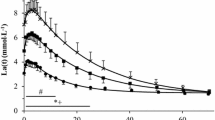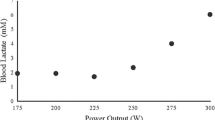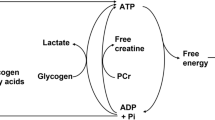Abstract.
The effects of 4 weeks of endurance training in conditions of normoxia or hypoxia on muscle characteristics and blood lactate responses after a 5-min constant-load exercise (CLE) at 90% of the power corresponding to the maximal oxygen uptake were examined at sea-level in 13 sedentary subjects. Five subjects trained in normobaric hypoxia (HT group, fraction of oxygen in inspired gas = 13.2%), and eight subjects trained in normoxia at the same relative work rates (NT group). The blood lactate recovery curves from the CLE were fitted to a biexponential time function: La<SUB>(</SUB><I><SUB>t</SUB></I><SUB>)</SUB>=La<SUB>(0)</SUB>+A<SUB>1</SUB>(1-e<SUP>-</SUP><SUP>γ</SUP><SUP>1·t</SUP>)+A<SUB>2</SUB>(1-e<SUP>-</SUP><SUP>γ</SUP><SUP>2·t</SUP>), where the velocity constants γ1 and γ2 denote the lactate exchange and removal abilities, respectively, A1 and A2 are concentration parameters that describe the amplitudes of concentration variations in the space represented by the arterial blood, La( t ) is the lactate concentration at time t, and La(0) is the lactate concentration at the beginning of recovery from CLE. Before training, the two groups displayed the same muscle characteristics, blood lactate kinetics after CLE, and γ1 and γ2 values. Training modified their muscle characteristics, blood lactate kinetics and the parameters of the fits in the same direction, and proportions among the HT and the NT subjects. Endurance training increased significantly the capillary density (by 31%), citrate synthase activity (by 48%) and H isozyme proportion of lactate dehydrogenase (by 24%), and γ1 (by 68%) and γ2 (by 47%) values. It was concluded that (1) endurance training improves the lactate exchange and removal abilities estimated during recovery from exercises performed at the same relative work rate, and (2) training in normobaric hypoxia results in similar effects on lactate exchange and removal abilities to training in normoxia performed at the same relative work rates. These results, which were obtained non-invasively in vivo in humans during recovery from CLE, are comparable to those obtained in vitro or by invasive methods during exercise and subsequent recovery.
Similar content being viewed by others
Author information
Authors and Affiliations
Additional information
Electronic Publication
Rights and permissions
About this article
Cite this article
Messonnier, L., Freund, H., Féasson, L. et al. Blood lactate exchange and removal abilities after relative high-intensity exercise: effects of training in normoxia and hypoxia. Eur J Appl Physiol 84, 403–412 (2001). https://doi.org/10.1007/s004210000378
Accepted:
Issue Date:
DOI: https://doi.org/10.1007/s004210000378




